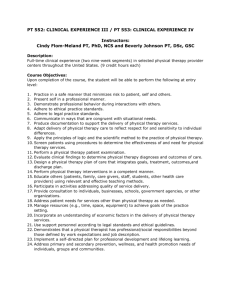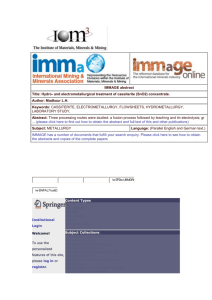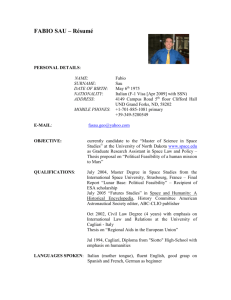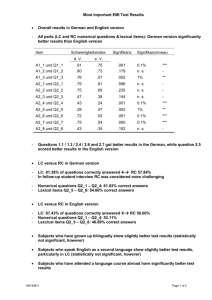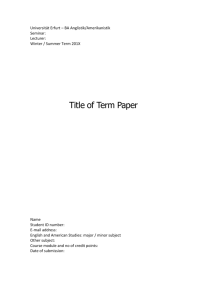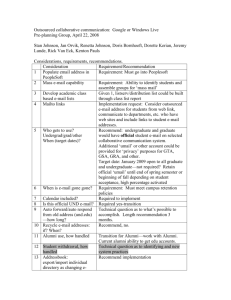Cultural Identity in a Globalised World final 2
advertisement
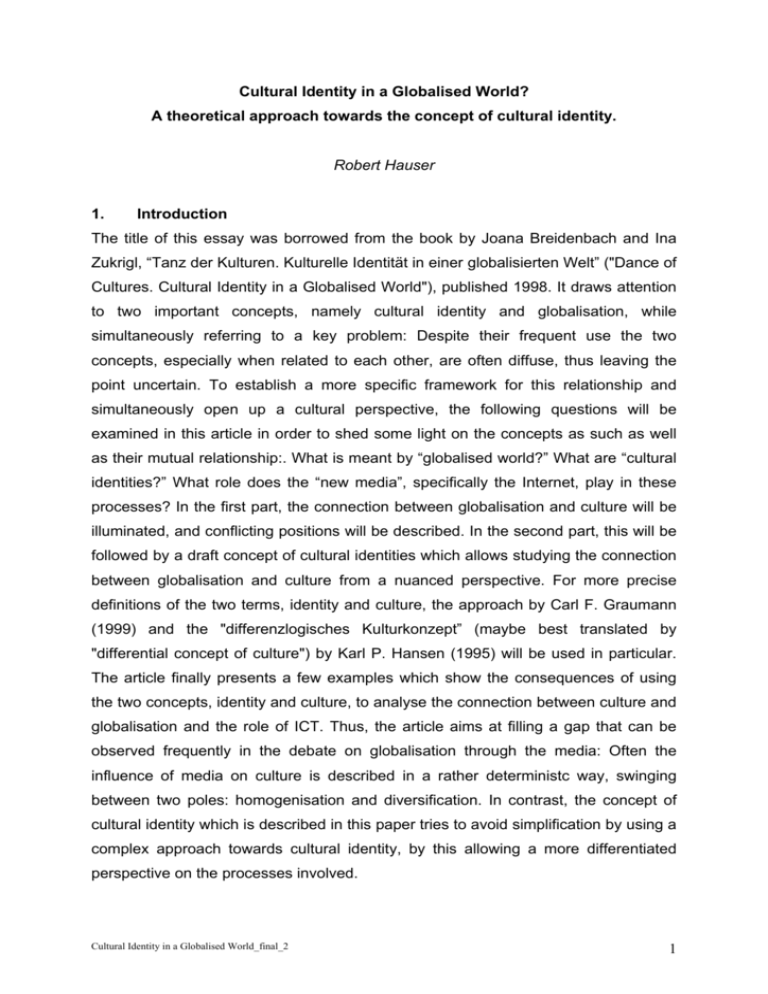
Cultural Identity in a Globalised World? A theoretical approach towards the concept of cultural identity. Robert Hauser 1. Introduction The title of this essay was borrowed from the book by Joana Breidenbach and Ina Zukrigl, “Tanz der Kulturen. Kulturelle Identität in einer globalisierten Welt” ("Dance of Cultures. Cultural Identity in a Globalised World"), published 1998. It draws attention to two important concepts, namely cultural identity and globalisation, while simultaneously referring to a key problem: Despite their frequent use the two concepts, especially when related to each other, are often diffuse, thus leaving the point uncertain. To establish a more specific framework for this relationship and simultaneously open up a cultural perspective, the following questions will be examined in this article in order to shed some light on the concepts as such as well as their mutual relationship:. What is meant by “globalised world?” What are “cultural identities?” What role does the “new media”, specifically the Internet, play in these processes? In the first part, the connection between globalisation and culture will be illuminated, and conflicting positions will be described. In the second part, this will be followed by a draft concept of cultural identities which allows studying the connection between globalisation and culture from a nuanced perspective. For more precise definitions of the two terms, identity and culture, the approach by Carl F. Graumann (1999) and the "differenzlogisches Kulturkonzept” (maybe best translated by "differential concept of culture") by Karl P. Hansen (1995) will be used in particular. The article finally presents a few examples which show the consequences of using the two concepts, identity and culture, to analyse the connection between culture and globalisation and the role of ICT. Thus, the article aims at filling a gap that can be observed frequently in the debate on globalisation through the media: Often the influence of media on culture is described in a rather deterministc way, swinging between two poles: homogenisation and diversification. In contrast, the concept of cultural identity which is described in this paper tries to avoid simplification by using a complex approach towards cultural identity, by this allowing a more differentiated perspective on the processes involved. Cultural Identity in a Globalised World_final_2 1 2. The Globalisation Debate and the Role of the New Media The very title of this essay, “Cultural Identity in a Globalised World?,” implies an ambivalent relationship between cultural identity and the globalised world. Cultural identities, first and foremost, are seen to have local roots. They are attached to local contexts, such as values, symbols, and language, and specified historically. Thus, they are in strained connection to the concept of the global which, in the cultural sciences, foremost describes generalisation and a decontextualisation of symbols, but also the detachment of social actions from specific locations and specific periods of time. The difficulties of analysing the globalisation concept are seen not only in definition but, above all, in the fact that the relevant processes and their consequences affect both the microscopic level, i.e. individuals, and the macroscopic level, i.e. the whole society. These two levels frequently are not studied separately. For this reason, the relationship between globalisation and the new media and their influences will be studied first on the microscopic level, and then the influences will be examined separately on the macroscopic-level. According to Breidenbach and Zukrigl (1998), there are indications, on the microscopic level, of a new relation of community, location, and culture: “For more and more people, such as migrants, businessmen, young people, scientists, artists, or Internet users, fixed geographic spaces are losing their importance as key points of reference with respect to identity and everyday life, giving way to deterritorialised communities linked by common social, professional, and private interests” (ibid., p. 142). The reasons cited for these changes include not only intensified migration processes and worldwide tourism, but chiefly the establishment of interconnected digital communication media all over the world. We live in the so-called “media age,” in which the greatest influence on the postulated socio-cultural changes is attributed to media interlinked worldwide. Anthony Giddens, a prominent author among those working on globalisation in recent years, feels that changes in the space-time relations of social actions play an important role. He defines globalisation: “as the intensification of worldwide social relations which link distant localities in such a way that local happenings are shaped by events occurring many miles away, and vice versa” (Giddens 1990, p. 64). He refers to progressive “disembedding” mechanism by “symbolic tokens”1 and “expert 1 E.g. money c.f. Giddens 1990, p. 22 ff. Cultural Identity in a Globalised World_final_2 2 systems” because both “remove social relations from the immediacies of context” and they also foster “the separation of time from space as the condition of the time-space distanciation which they promote” (ibid., p. 28). Therefore those mechanisms are crucial for disembedding social relations from location-related interaction situations and provide “'guaranties' of expectations across distanciated time-space” (ibid., p. 28). This changes the relevance and the binding force of specific space-time contexts, such as national identities (ibid., p. 65). Socio-cultural globalisation processes, accordingly, are brought about by “’revolutions’ in information and communication technologies” (Sterbling 2000, p. 81), resulting in a “stretching” of space-time social interaction (cf. Giddens 1990, p. 64 ff.). It is a stretching inasmuch as the Internet (as a conglomerate of various applications) is not a mass medium in the classical sense of the term (as printed media, radio, television are), but a new communication technology. It allows data in a digitised form to be exchanged in both directions, i.e. from the sender to the recipient and back, over any distance. In this way, local modes of participation are stretched globally, allowing interactions to take place even over long distances. The worldwide real time availability achieved by the Internet increases the interaction potentials among individuals and organisations, respectively, in regions physically separated from each other, thus reinforcing the tendencies of reorganisation of the relations of time, space and culture (cf. ibid., p. 64). Social networks of persons, i.e. communities, no longer develop only in places where people meet in the flesh at a specific point in time, but as links between any location where it is possible to “log in,” and where there are facilities for sending and receiving messages, independent of time and space (cf. TAB 2005, p. 56). The new information and communication technologies thus build a bridge between local contexts, such as cultural identities, and global contexts, and the spread of uniform systems of symbols, lifestyles, and stereotypes (cf. Schmidt 1999, p. 125). According to Breidenbach and Zukrigl, the Internet therefore can be seen as a suitable tool for promoting intercultural exchange by means of which even very small language and interest groups can network and express themselves (cf. Breidenbach/Zukrigl 1998, p. 23). They go on to conclude: “The world is fragmented by globalisation. The exponential increase in contacts of people and societies enhances knowledge of alternative ways of life, values, and concepts. […] Exchanges with global influences produce new forms of culture" (Breidenbach/Zukrigl Cultural Identity in a Globalised World_final_2 3 1998, pp. 35-7). Other authors, such as Siegfried J. Schmidt (1999), Detlef Nothnagel (2000), and Juliana Roth (2000), postulate similar consequences of media-induced globalisation. They argue that the worldwide network of media is able, on the one hand, to observe everything and, on the other hand, to be received anywhere by anybody. This results in observations which add to the contingency experiences. Anybody nowadays receiving media or, as with the Internet, actively participating in them learns that everything could just as well be fundamentally different, that others see everything quite differently, and do, judge, and perceive things differently (cf. Schmidt, 1999, p. 123). In addition to producing an experience contingency, the main individual consequences of Internet technology consist in changing the quantitative factors of communication. Via the Internet, information, communication, and participation become much simpler, faster, and less expensive (cf. TAB-2005, p. 56). It also increases the availability of information and new sources of information, while at the same time, classical gatekeepers, such as print media and broadcasting, are more and more losing that function. Internet search engines, such as Google, Yahoo, and Lycos, enable anybody with access to them to engage in rapid searching, and researching for, and selecting information. In this way, sources of information far outside a person’s local context can be tapped much more easily, quickly, and cheaply than before. On the macroscopic level, however, the cultural and social consequences of the possibilities offered by the globalised media are considered as problematic with respect to the process of locally based identity formation. Roth (2000) put it in a nutshell like this: “Wider opening to the outside is causing internal fears of a loss of identity” (p. 100). Experiences of contingency generated by the media are expected to result in a pluralisation of "Lebenswelten" (sometimes translated as "life-worlds") (cf. Nothnagel 2000, pp. 65 ff.). Knowledge of other or different forms of everyday life and existence accordingly lead to insecurity among individuals and a relativisation of their values and worlds of living. This process of uprooting, understood here as a loss of cultural tradition, is said to force individuals to redefine their identity. The conclusions for culture derived from this scenario are formulated in two diametrically opposed theses: as fragmentation thesis on the one hand, and, homogenisation (or leveling) thesis on the other hand. Under the heading of the fragmentation thesis, several scenarios are covered. Thus, the process (in addition to the consequences of Cultural Identity in a Globalised World_final_2 4 the modern age 2) could cause further differentiation of societies. The increasing adoption of culturally foreign ways of life and work at the same time makes integration into local cultural contexts more and more difficult. The buzzwords describing this mixing of culturally different styles, customs and traditions, are cultural pluralisation, hybridisation3 and creolisation4, respectively (cf. Luger/Renger 1994; Hannerz 1987). Besides the mixing of “own” and “foreign” cultures, there are indications of cultural identities being again based more and more on local traditional patterns. The permanent presence of foreign images as transmitted by the new electronic media drains and undermines national identity by showing images of the world and ways of life and action which contradict one’s own cultural contexts. It is feared that this would result not only in a loss of national cultural bonds, but give rise to a kind of defence reaction against the excessive offerings of foreign cultural symbols, thus leading to an even more pronounced search for locally based cultural identification (cf. Nothnagel 2000; Barber 1997; Castells 2001). Symptoms of this phenomenon could be, for example, designs of identities based on local patriotism or nationalism of the kind diagnosed partly for Eastern Europe (cf. Roth 2000, p. 97). Furthermore, the worldwide interconnectedness of mass media, and the resulting increase in the spread of contingency experiences, make the cultural processes of socialisation and identity formation more difficult and complex. All these different tendencies could cause increasing fragmentation of national societies and their cultures. This image, which is called fragmentation thesis, is opposed by the thesis of leveling and homogenisation, which is encountered no less frequently. According to this concept, cultural standardisations (as systems of symbols) of individual societies, e.g. for evaluating and assessing media contents, would be disseminated globally. As Internet communication takes place mainly among users from high-tech industrialised countries influenced by Western culture, and is carried on mainly in English, the communication standards established by these users, some of them normative (e.g. Netiquettes), are globalised (cf. Huber 1997, p. 73). The main arguments in favour of this thesis are empirically backed findings that “media communication normally is more dense from the centres to the peripheries than the other way around” (Saxer 1989, quoted from Saxer 1999, p. 104). That there is more communication from the centres (the Western industrialized nations) to the 2 3 4 As a result of enlightenment, secularization, and individualization. Mixed cultures, such as the culture of persons of Turkish extraction born in Germany. Thorough mixing of various cultures. Cultural Identity in a Globalised World_final_2 5 peripheries (industrially weaker states, mainly non-Western states) frequently gives rise to the fear of an inevitable process of adaptation of formerly culturally different societies to one global system of symbols (primarily a system of Western cultural symbols and language)5 which then forms the background for a global cultural identity. As was pointed out above, both theses, fragmentation as well as homogenisation can be seen as two sides of the same medal. They result from a rather simplistic, media deterministic perspective (cf. Saxer 1999, p. 115). 3. The “Cultural Identity” Concept As can be seen from the discussion of "cultural globalisation" and the outlined arguments, theses and apprehensions as well as hopes attached to the subject, the concept of "identity", mostly in terms of "cultural identity", plays a key role. It is striking to see in this connection that the term as such is mentioned frequently, but is explained only in very few cases. Studying the processes of mediated globalisation, and their influences on and consequences for identity (especially cultural identity), requires a closer look at the “cultural identity” construct. Theoretical conceptualisation is particularly difficult because the two terms per se incorporate a whole range of possible meanings and concepts. The concept of cultural identity, for this reason, will be derived from a psychological approach in the section below (2.1), and cast into more specific terms in 2.2 by means of a more informative concept of culture. 3.1. The Social Identity Theory and Cultural Identity Graumann (1999) points out that the identity concept, as used in the social and cultural sciences with regard to culture, originates from psychology. It turns up first in the psychoanalytical concept of Sigmund Freud and was developed later into the theoretical concept of “self-identity” by Erik H. Erikson (cf. Graumann 199, p. 59). This basically refers to the succession of individual psychological crises. The term 5 “…increased contact has led to the spread …. of Western (especially US) cultural practices. Traditional dress has been replaced by suits in business settings in every country in the world; young people in urban areas everywhere watch films made in Hollywood, listen to Rock´n Roll, play video games, talk on cell phones, wear jeans, drink Coke, eat pizza (or McDonald’s hamburgers), speak English and, increasingly, frequent cybercafés” (Herring 2001, Foreword). Cultural Identity in a Globalised World_final_2 6 “crisis” must not necessarily be given a negative connotation (as in everyday usage); generally speaking, a crisis is the moment of decision whether a development will succeed or fail. In the 1980s, Henri Tajfel (1982) developed the Social Identity Theory (SIT) on the basis of minimal group experiments he performed (cf. Abrams/Hogg 1999). The SIT is mainly about the individual processes of categorising perception, e.g. of one’s own self, of other people and the environment. The underlying assumption is that people establish categories in the form of stereotypes in an effort to structure and systematise their environment. Previously, it was assumed that this was done because people have a very limited ability to perceive and process information from their environment. Now Tajfel for the first time pointed out that a social function could be hidden behind these stereotyping mechanisms (cf. ibid. p. 9). Thus, according to Tajfel, stereotyping helped to assess and allocate social contexts and social distinctions (cf. Abrams/Hogg 1999, p. 9)6. This allows a clear distinction to be made between members and non-members of a category7. In the course of this social categorisation, people not only classify others as members of specific categories, but at the same time also categorise themselves. In this way, categories provide their members with a self-referential system placing individuals within their social environments and, consequently, contributing to the development of social identity. The SIT links group processes, on the one hand, with individual processes, on the other hand. However, the term "culture" does not come up in this concept. It will be shown below with Graumann (1999) that the term "identification" can be used to build a bridge connecting social identity with cultural identity. As seen from the identification concept, identity mostly means three things: identifying others, being identified oneself, and identifying with others. According to Graumann, who refers to Harold Proshansky (1978), “any social identity […] not only is incorporated in an interpersonal-interactive framework, but also always is related to locations and things” and directed at symbols (Graumann, 1974, as quoted from Graumann 1999, p. 64). “What can be symbolised by locations and things and persons ultimately are values, all of which define a culture" (ibid., pp. 67 ff.). Identification, and thus also part of identity, consequently is always value-related, representing identification with a 6 In the original text: “[…] such as justification, causal attribution, social differentiation” (Abrams/Hogg 1999, p. 9). 7 Categories in this case are social groups or communities. Cultural Identity in a Globalised World_final_2 7 community sharing these values. This provides us with a first idea of what is meant by cultural identity: identification with specific values and, in this way, at least partial membership in the groups representing these values. Such value-related and, hence, cultural identity can also be built on non-identification or negation of other values and their symbolic expressions (e.g. anti-nuclear stance, anti-capitalism, etc.), thus allowing a distinction to be made between positive and negative cultural identification. If cultural identity is understood in this sense, it has an integrating effect, on the one hand while, on the other hand, serving to mark group members and exclude non-members. As every individual is member of several such communities of values at the same time and successively in the course of his or her life, and is able to identify with them (multi-collectivity), respectively, the act of negotiating identification versus negation must be performed again and again. Cultural identity therefore must be considered a process, often full of conflicts and designed so as to be heterogeneous, which ultimately constitutes its dilemma. Between the past and the future, there is the temporal aspect of cultural identity: “What man is, is told only by his history” (Dilthey 1931, p. 224). Cultural identity almost always has problematic connotations because it must first be searched for (in the past), then must be found and developed, respectively (in the present), or because it threatens to be lost (in the future) (cf. Graumann 1999, p. 60). 3.2 The Concept of "Culture” within the Concept of “Cultural Identity” Also the concept of culture, like the concept of identity, can be used for many purposes and, consequently, is often modified to suit a particular topic (cf. Saxer 1999, p. 98). Philosophy, sociology, ethnology, cultural sciences, and transdisciplinary schools, such as Cultural Studies, have tried to describe and characterise what they regard as culture8. Even within specific disciplines, the concept of culture often remains vague and ambivalent. The theoretical difficulties begin with the many forms culture can take, and end with the paradoxes encountered in the scientific assessment of the phenomenon of culture9. Culture is frequently 8 See also Gerhards 2000, Introduction; Moosmüller 2000, p. 16. Demorgon and Molz, inter alia, mention three paradoxes of culture frequently cited in the literature: “continuity and change, standardization and differentiation, opening and exclusion” (1996, p. 50, emphasis in the original text). 9 Cultural Identity in a Globalised World_final_2 8 described as an orientation or standardisation of values or modes of behaviour (i.e. as being standardised) while, on the other hand, there is also room for individual variation, subcultures, and very small communities which make cultures appear divergent (cf. Demorgon/Molz 1996, pp. 43 ff.). The “differential” 10 ("differenzlogische") concept of culture developed by Hansen (1995) allows this (seeming) paradox to be resolved. Instead of regarding culture as a holistic entity in the sense of Johann G. Herder (1774), Hansen develops a concept of culture explaining the unity of culture on the basis of its differentiated nature. For the example of Germany, a large number of different ways of life can be found within German culture. Considering, for instance, the way of life of a carpenter in Lower Bavaria as compared to that of a manager working at the Frankfurt Stock Exchange, it would be difficult at first sight to find many things their everyday lives have in common. It would be much easier to describe the differences. Yet, although their ways of life and everyday activities may seem to be very different in detail, there are certain common features characterising these two persons as members of the same culture. These common features, to which Hansen also refers to as “glue”, initially are the common language and the common history, either lived or handed down (Hansen, 1995, p. 179).11 Language is not only an output or transfer medium allowing verbal communication to take place, but is closely connected to perception and reason. It not simply names things, but assigns to them meaning by placing them into context (cf. ibid., p. 62). In this way, every language community has its own perception of real life produced by the meanings generated in its language which, in turn, promotes cohesion and acts as a mechanism of inclusion and exclusion. Also history constitutes a sphere of significance of its own. It affects the reality of life and sustainably influences thinking and acting by traditions and historical holidays and memorial days. Language and history are mutually interdependent: on the one hand, because history is handed down by language; on the other hand, because language itself has grown historically and is changed by historic events. Language and history promote the cohesion of a society and constitute a first background of cultural influence. However, in some way, this is involuntary because it is achieved by birth and socialisation. Socialisation, i.e. education, makes an individual not only learn the 10 For this concept, see: Drechsel/Schmidt/Gölz 2000, pp. 16 ff. A common history (historical facts) does not necessarily lead to common views of that history, but constitutes the point of departure of, and a common point of reference for, these views. 11 Cultural Identity in a Globalised World_final_2 9 native language and experience something of the specific history relevant to the society of that individual, but also brings about an introduction to, and incorporation into, the organisation of society and its institutions. These symbolise the patterns of action and reasoning as well as the underlying value concepts typical of the respective culture. These standardisations constitute the framework of what the members of a culture consider “normal.” The institution of birthday can be used to illustrate these value-based standardisations as micro-normative criteria: "Rejoice, invite friends, prepare special food and drinks, accept presents and be grateful” (ibid., p. 110). Emotional criteria are just as important in this respect as other decisionmaking criteria of an institution, because they also serve to establish security in behaviour. “If somebody does not stick to the rules, interaction is interrupted, the others are confused, and he or she may be considered eccentric or even mad” (Argyle 1972, p. 84). In most instances, these cultural rules are not written out in full and are acquired rather subconsciously as a result of socialisation. Etiquettes, ethical norms and legal standards constitute exceptions, because some of them may be formulated (etiquettes and ethical standards) or even written down (legal norms). Consequently, cultural standardisations are normative collective criteria with different restrictive implications depending on the degree in which they have been formulated (norms of habit, value, ethical and legal norms). Unlike societal framework conditions (such as language and history), the choice among available interpretations of action and meaning offers some freedom of decision, namely in the possibility to decide for or against membership in a group and its conditions. As briefly alluded to above under the identity concept, there may be any number of permanently changing groups or collectives within cultures12. In addition to the family community, membership in which is established by birth, there are numerous other groups in most societies where membership and identification, at least from a specific age onward, are voluntary and optional (cf. Hansen 1995, p. 139). Each group negotiates specific standardisations by communication. According to Hansen, these standardisations apply to communication, thought, feeling, behaviour, and action. The individual is free to decide, within his or her socialised 12 It must be assumed that the number of eligible collectives varies depending on the society concerned. Cultural Identity in a Globalised World_final_2 10 framework conditions13, among existing groups and communities of like mind, but his or her decision (in favour or against special groups) and her or his action (within various groups) is not without social consequences. Membership in one group may aggravate or even exclude access to others (cf. Hansen 1995, p. 140). According to Hansen, one can therefore stress: “Individuals make up a group, and the group forms individuals who acquire their identities in response to collective criteria” (ibid., p. 177). The interaction between the individual and the group this implies is expressed by Hansen as follows: “On the one hand, culture [in the form of collectivised norms] is created by individuals but, on the other hand, it creates their identity” (Hansen 1995, p. 213). Hansen’s concept of culture separates the identity concept from the individual, and thus from the microscopic level, and links it to the macroscopiclevel of groups or collectives. Again, the interrelation between the concept of cultural identity and the group level becomes evident (as indicated in the section on identity above). This means that individuals identifying with specific groups and their values (in the form of normative cultural standardisations) at the same time are shaped mentally by these very standardisations. By living these standards, they make them their cultural identity. Membership of individuals in specific groups is communicated externally by symbols expressing cultural identity, thus ensuring identifiability. Cultural identities influence e.g. behaviour and communication of individuals not only by mental structuring, but also act as mechanisms of inclusion and exclusion (cf. ibid., p. 113). As a rule, individuals are members not only of one group, but of many groups. When referred to cultural identity, membership of individuals in many groups implies that cultural identity is not a permanent state, but its emergence must be considered an ongoing process. This process takes place within and between various groups of which the individual is a member. These groups “provide the concepts of thinking, feeling, and behaviour from which, partly consciously, partly unconsciously, the unique mix of “existence” is recruited. The very membership in various groups, and the resulting 13 Pierre Bourdieu in “Distinction: A Social Critique of the Judgement of Taste” (1987), refers to the concept of “cultural capital”; Bourdieu considers it to be attached to socialisation in, and membership of, specific social strata. Cultural Identity in a Globalised World_final_2 11 combination of standardisations thus ensure an individual’s uniqueness” (Hansen 1995, p. 177). By linking the two concepts of identity and of culture, we can make a first approach to define cultural identity: First of all, it is important to note, that groups and individuals are mutually based on each other. Individuals form a group which in turn influences the individuals. Moreover, these individuals attain their identities in close reaction to collective values (formed via communication between the group members) and normative standardisations existent in a given group. In order to identify oneself with a certain group, symbols are used which can be seen as standardised devices of communication, thought, feeling and behaviour. As one individual belongs to more than one group, cultural identity cannot be described as fixed state, but rather is constantly formed anew by referring (or not referring) to a number of possible group norms and values. Having said this, the line of arguments outlined above about the fragmenting and homogenising influences, respectively, of the new Internet-based media (ICTs) can now be put into more concrete terms with respect to this concept of cultural identity. A perspective different from this media deterministic argument is opened up by using the concept of cultural identity outlined above. Linking the concept of cultural identity specified in the part on identity (3.1) and intensified in the part on culture (3.2) to collectivity in this article allows a different picture to be developed of the impact of messages globalised by the mass media on cultural identity: Modes of thinking, mentality and acting are influenced greatly by membership in specific groups. This means that media are received by individuals, but the information disseminated in this way is always evaluated and classified with respect to the prestructured cultural standardisations of groups. Media reception research arrives at similar conclusions, at least with regard to the classical mass media. It has been demonstrated, for instance in detailed empirical studies, that the same fictional media content, such as the American soap opera “Dallas,” is received in a specific cultural way by different groups of recipients (cf. Liebes 1988; Liebes/Katz 1990). This would argue in favour of the assumption indicated above that a given cultural context plays an important part in processing Cultural Identity in a Globalised World_final_2 12 and offering patterns of perception, thought, interpretation, and action. They guarantee a continuous process of embedding contingency experience in one´s own personal cultural context. There is a general demand to take into account in analyses of this transdisciplinary complex of topics the findings already made and validated in individual disciplines as shown above with reference to important studies about media reception. They allow the conclusion: “Cultural identity obviously can be expressed in different ways, as a specific function of culture, of processing identical stimuli of communication” (Saxer 1999, p. 105, emphasis in the original text). Next, in order to shed more light on the relationship between cultural identity and the Internet, questions about a culturally differing use of the Internet in a qualitative sense should be asked. If communication is considered to be a standardisation specific to a culture, as was postulated by Hansen, it should be possible to demonstrate such differences also empirically in the different uses of the Internet. Some first empirical approaches along these lines exist, e.g., in the field of Cultural Studies, for instance studies of websites (e.g. Leonardi 2002; Marcuse/Gould 2000; Würtz 2004), but in most cases highly condensed macro-theoretical cultural models are used, such as those by Edward Hall (1990) or Geert Hofstede (1993). Despite different approaches to the problem, most macrotheories categorise culture by establishing more or less differentiated “cultural dimensions.” However, working with cultural dimensions is bound to lead to a high degree of stereotyping and, thus, simplification, in which process many phenomena will be missed. As a result of these macro-theoretical approaches, abstract averages are generated which say little or nothing about specific cultural actions of individuals. The use of cultural dimensions at best has a descriptive, but no explanatory function (cf. Bolten 2001, p. 131). So, if cultural phenomena are not only to be described but also explained, empirical studies must be preceded by a differentiated, informative concept of culture. The concept of cultural identity as presented here, first of all, can offer two possibilities to examine culture in a more specific way: (1) Culture in this case is considered both at group level and at the level of the individual, and both micro- and macro-analytical perspectives are thus integrated into one concept. Cultural Identity in a Globalised World_final_2 13 (2) Differentiation into various groups allows specific groups of different cultures to be compared, thereby avoiding the generalisation or excessive stereotyping of culture. Other potentials with respect to studies of groups, given appropriate specification, stem from web-based communication. Web-based communication, with its manifold possibilities of communication and interaction, represents one possible extension of the possibilities of “socialising” (group formation and group communication). Unlike the telephone the Internet, with its one-to-many and many-to-many communications, offers platforms for collective communication. These platforms (such as web-based online forums or blogs) can be used by existing groups to enhance their density of communication, or entirely new forms of collectivisation may be generated, such as online communities. With the help of approaches from psychology as well as cultural theory, especially with regard to Hansen, the article aimed at defining cultural identity in a more precise and complex way than it can often be found in theoretical papers. As was pointed out, the mutual relationship between cultural identity and (global) new media, cannot adequately be described by theses of either homogenisation or diversification of cultures. Rather, cultural identity should be subject to differentiated analysis within various cultural contexts. Cultural Identity in a Globalised World_final_2 14 Literature: Argyle, M. (1972): Soziale Interaktion. Köln Barber, B. (1997): Coca-Cola und Heiliger Krieg: Wie Kapitalismus und Fundamentalismus Demokratie und Freiheit abschaffen. Bern/München/Wien Beck, U. (1997): Was ist Globalisierung? Frankfurt/M. Bolten, J. (2001): Kann man Kulturen beschreiben oder erklären, ohne Stereotypen zu verwenden? Einige programmatische Überlegungen zur kulturellen Stilforschung. In: Bolten, J.; Schröter, D. (Hg.): Im Netzwerk interkulturellen Handelns. Theoretische und praktische Perspektiven. Sternenfels, S. 128-142 Bourdieu, P. (1987): Distinction: A Social Critique of the Judgement of Taste. Cambridge Breidenbach, J.; Zukrigl, I. (1998): Tanz der Kulturen. Kulturelle Identität in einer globalisierten Welt. München Burckhardt, J. (1988): Die Kultur der Renaissance in Italien. Stuttgart. Castells, M. (2001): Die Netzwerkgesellschaft. Bd.1: Das Informationszeitalter. Opladen Demorgon, J.; Molz, M. (1996): Bedingungen und Auswirkungen der Analyse von Kultur(en) und interkulturelle Interaktion. In: Thomas, A. (Hg): Psychologie interkulturellen Handelns. Göttingen/Bern, S. 43-80 Dilthey, W. (1977): Ein Traum. Entwurf seiner Rede zu seinem 70. Geburtstag. [1931] In: Dilthey, W. Gesammelte Schriften Bd. 8, Weltanschauungslehre (5. Aufl.). Stuttgart, S. 218 - 224 Döring, N. (1999): Sozialpsychologie des Internet. Die Bedeutung des Internet für Kommunikationsprozesse, Identitäten, soziale Beziehungen und Gruppen. Göttingen u. a. Drechsel, P.; Schmidt, B.; Gölz, B. (2000): Kultur im Zeitalter der Globalisierung. Von Identität zu Differenzen. Frankfurt/M. Erikson, E. H. (1968): Identity, psychosocial. In: International Encyclopedia of the Social Science Bd. 7. New York, S. 61-65 Gerhards, J. (2000): Die Vermessung kultureller Unterschiede. Deutschland und USA im Vergleich. Opladen Geertz, C. (1973): Thick Description: Towards an Interpreatative Theory of Culture, in idem, The Interpretation of Cultures: Selected Essays. New York . Giddens, A. (1990): Konsequenzen der Moderne. Frankfurt/M. Graumann, C. F. (1999): Soziale Identitäten. Manifestation sozialer Differenzierung und Identifikation. In: Viehoff, R.; Segers, R. T. (Hg.): Kultur, Identität, Europa. Frankfurt/M., S. 59-74 Hall, E.; Hall, M. (1990): Understanding Cultural Differences: Germans, French and Americans. Yarmouth Hannerz, U. (1987): The World in Creolisation. In: Africa. Journal of the International African Institute Jg. 57, 1987, Heft 4, S. 546- 559 Hansen, K. P. (1995): Kultur und Kulturwissenschaft (1. Aufl.). Tübingen/Basel Hansen, K. P. (2003): Kultur und Kulturwissenschaft (3. Aufl.). Tübingen/Basel Heidenreich, M. (1998): Die Gesellschaft im Individuum. In: Schwaetzer, H.; StahlSchwaetzer (Hg.): L`homme machine? Anthropologie im Umbruch. Hildesheim/Zürich/New York, S. 229-248 Herring, S. (2001): Foreword. In: Ess, C.; Sudweeks, F. (ed.): Culture, Technology, Communication. Towards an Intercultural Global Village. Albany, S. 7-14 Hogg, M. A.; Abrams, D. (1999): Social Identity and Social Cognition. Oxford Cultural Identity in a Globalised World_final_2 15 Hofstede, G. (1993): Interkulturelle Zusammenarbeit: Kulturen-OrganisationManagement. Wiesbaden Huber, H. D. (1997): Welcome to Securetyland. Die Globalisierung von Kommunikation und Kultur im Internet. In: kritische berichte. Zeitschrift für Kunst- und Kulturwissenschaften, Jg. 25, 1997, Heft 1, S. 70-79 Lash, S. (1996): Reflexivität und ihre Doppelungen: Struktur, Ästhetik und Gemeinschaft. In: Beck, U.; Giddens, A.; Lash, S. (Hg.): Reflexive Modernisierung. Eine Kontroverse. Frankfurt/M., S. 195-286 Lash, S. (1998): Wenn alles eins wird. Wir leben in einem Zeitalter der globalen Kulturindustrie. Darin liegen auch Chancen. In: die Zeit Nr. 10, vom 26.02.1998, S. 41-42 Leach, E. (1987): Kultur und Kommunikation. Frankfurt/M. Leonardi, P. M. (2002): Cultural Variability in Web Interface Design: Communicating U.S. Hispanic Cultural Values on the Internet. In: Sudweeks, F.; Ess, C. (ed.): Fourth International Conference on Cultural Attitudes towards Technology and Communication 2004. Murdoch, S. 297-315 Liebes, T. (1988): Cultural Differences in the Retelling of Television Fiction. In: Critical Studies in Mass Communinication, Jg. 5, 1988, Heft 4, S. 277-292 Liebes, T.; Katz, E. (1990): The Export of Meaning. Cross-cultural Readings of Dallas. New York/Oxford Luger, K.; Renger, R. (Hg.) (1994): Dialog der Kulturen. Wien Marcuse, A.; Gould, E. W. (2000): Cultural Dimensions and Global Web User. Interface Design: What? So What? Now What? Austin McLuhan, M. (1995): The global Village: der Weg der Mediengesellschaft in das 21. Jahrhundert. Paderborn Moosmüller, A. (1996): Interkulturelle Kompetenz und interkulturelle Kenntnisse. Überlegungen zu Ziel und Inhalt im auslandsvorbereitenden Training. In: Roth, K. (Hg.): Mit der Differenz leben: Europäische Ethnologie und Interkulturelle Kommunikation. Münster u. a., S. 8-20 Nothnagel, D. (2000): Lokalität und Globalität. In: Alsheimer, R.; Moosmüller, A.; Roth, K. (Hg.): Lokale Kulturen in einer globalisierenden Welt. München/Berlin, S. 55-79 Roth, J. (2000): Globalisierung im Westen – Lokalisierung im Osten? Europäische Reaktionen auf Integration in Politik und Wirtschaft. In: Alsheimer, R.; Moosmüller, A.; Roth, K. (Hg.): Lokale Kulturen in einer globalisierenden Welt. München/Berlin, S. 89-103 Saxer, U. (1989): Medienkommunikation und geplanter Gesellschaftswandel. In: Kölner Zeitschrift für Soziologie und Sozialpsychologie, 1989, Sonderheft 30, S. 85-98 Saxer, U. (1999): Kulturelle Identitätsmuster und Medienkommunikation. In: Viehoff, R.; Segers, R. T. (Hg.): Kultur, Identität, Europa. Frankfurt/M., S. 98-120 Schmidt, S. J. (1996): Kognitive Autonomie und soziale Orientierung. Konstruktivistische Bemerkungen zum Zusammenhang von Kognition, Kommunikation, Medien und Kultur. Frankfurt/M. Schmidt, S. J. (1999): Kultur als Programm. Zur Diskussion gestellt. In: Viehoff, R.; Segers, R. T. (Hg.): Kultur, Identität, Europa. Frankfurt/M., S. 120-129 Sterbling, A. (2000): Globalisierung und die Ungleichzeitigkeiten des Denkens. In: Alsheimer, R.; Moosmüller, A.; Roth, K. (Hg.): Lokale Kulturen in einer globalisierenden Welt. München/Berlin, S. 79-89 Tajfel, H. (1982): Gruppenkonflikt und Vorurteil: Entstehung und Funktion sozialer Stereotypen. Bern/Stuttgart/Wien Cultural Identity in a Globalised World_final_2 16 Würtz, E. (2004): Intercultural Communication on Websites. In: Sudweeks, F.; Ess, C. (ed.): Fourth International Conference on Cultural Attitudes towards Technology and Communication. Murdoch, S. 109-132 Abstract: The relation between globalisation and culture with respect to the use of media, especially the new web-based media, is described in a general sense, and opposed positions are presented. It is shown that a valid concept of cultural identity is needed to describe this relationship in specific terms and subject it to differentiated analysis. A concept of cultural identities is outlined which is to allow this connection to be studied in a nuanced light. Finally, its pointed out that rather cultural identity should be subject to differentiated analysis within various cultural contexts. Information about the Author: Robert Hauser, M. A., studied cultural sciences, communication and media sciences as well as religious science at the University of Leipzig. Since August 2004 he has been a PhD-student with the Institute for Technology Assessment and Systems Analysis (ITAS) of the Karlsruhe Research Centre. His main research areas are cultural change as a result of web-based communication; new media, and media culture. At present, he is involved in these research projects: Cultural conditions and consequences of information technology. Head of project: Prof. Dr. Gerhard Banse (IIT, Cottbus Technical University); European Research Network on Cultural Diversity and New Media (CULTMEDIA); Head of project: Prof. Dr. Gerhard Banse (IIT, Cottbus Technical University). Contact data: Robert Hauser M. A. Institut für Technikfolgenabschätzung und Systemanalyse (ITAS) E-mail: Robert.hauser@itas.fzk.de Phone: +49 (0) 7247-82-6487 Fax: +49 (0) 7247-82-6045 Cultural Identity in a Globalised World_final_2 17

